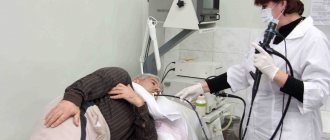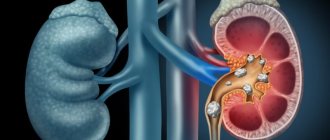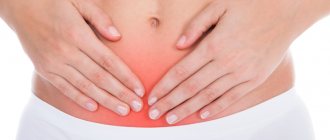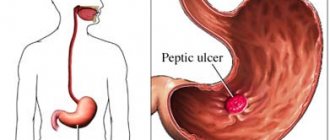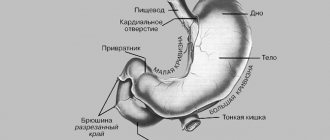Despite the dynamic development of innovative gastroenterological diagnostic methods, FGDS (fibrogastroduodenoscopy) remains the most accurate and informative. The procedure is carried out by introducing a fibrogastroscope through the oral cavity into the patient’s internal organs.
Using the backlight located on the device, the doctor has the opportunity to examine in detail the hollow organs of the digestive system. In addition, special forceps are used to collect tissue (biopsy) and gastric juice for subsequent analysis.
Fibrogastroduodenoscopy determines the presence of gastrointestinal pathologies such as: stenosis (narrowing of the lumen), ulcers and erosion, malignant or benign tumors, food obstruction, diverticula (protrusions of the colon wall), dysfunction of muscle valves (gastric sphincters). How often an FGDS can be done is decided by the gastroenterologist, based on the patient’s symptoms.
Purpose of FGDS
Gastroenterological examination is prescribed based on health status and complaints to diagnose the disease, and for patients with chronic gastrointestinal pathologies for preventive purposes.
The main indications for the procedure are:
- a burning sensation in the epigastric region, otherwise long-term heartburn;
- painful manifestations in the digestive system of unknown etiology;
- systematic vomiting and nausea;
- swallowing disorder (dysphagia);
- lack or sharp decrease in appetite;
- presumptive diagnosis of ulcerative changes;
- suspicion of cancer;
- control of chronic disease.
The examination is not prescribed in the post-insulin and post-infarction periods, in severe condition of the patient, with a history of impaired hemostasis (blood clotting), in patients with bronchial asthma, as well as in people with mental disorders.
Carrying out FGDS during pregnancy is not contraindicated, but is carried out only when absolutely necessary, when other methods of making a correct diagnosis do not work. FGDS does not affect a woman’s menstrual cycle, so it can be performed on critical days.
Conditions in which it is better to refuse gastroscopy
When an examination is prescribed by a doctor to clarify the diagnosis or to monitor the treatment being carried out, the doctor always conducts a full examination of the patient and identifies all contraindications.
But for preventive research, it is now not necessary to take a referral from a gastroenterologist; this procedure can be done for a fee in a clinic that a person trusts more.
But since the last FGDS, a person’s general health condition may have worsened, so before going for the next scheduled examination, you should familiarize yourself with the contraindications:
- hypertension with frequent crises;
- condition after a stroke;
- recent heart attack;
- heart disease associated with rhythm disturbances;
- blood diseases;
- esophageal stenosis.
This is considered an absolute contraindication and, if such diseases have appeared since the last examination, it is better to consult a doctor. Perhaps the doctor will suggest an ultrasound (ultrasound examination) or x-ray instead of gastroscopy to determine gastric pathology.
It is recommended to postpone routine examination for a while in case of upper respiratory tract infections. This is due to the fact that when performing fibrogastroscopy, the patient needs to breathe through the nose, and with respiratory infections, nasal breathing can be very difficult. In addition, when a gastroscope is inserted, it is possible to introduce pathogenic pathogens from the nasopharynx into the esophagus or stomach. It is worthwhile to first cure infectious diseases, and only then undergo an FGDS.
Source: zheludoc.ru
Frequency of examination
Fibrogastroduodenoscopy is a method that does not pose a health hazard, but does cause some discomfort to the patient. This is why many people ignore this study. It should be remembered that FGDS is the most accurate diagnosis and allows you to identify disorders and pathologies of the gastrointestinal tract at the earliest possible stage of their development.
FGDS of the stomach can be done often, as much as necessary according to the indications. The initial examination is prescribed upon presentation of patient complaints of painful and unpleasant sensations. If no serious disease is detected, subsequent fibrogastroduodenoscopy is not necessary.
When diagnosing a pathology, the frequency of the procedure will depend on its nature. A repeat examination may be scheduled at the end of a course of therapy or several times during the process to assess the effectiveness of the treatment.
Uncomplicated diseases of the gastrointestinal tract are monitored annually. Typically, exacerbations occur in the off-season. Identification of serious pathologies and previous operations on the gastrointestinal tract require increased attention. In this case, the interval between examinations can be reduced to 3–6 months. Since FGDS does not cause harm, there are no restrictions on the number of procedures performed.
If the doctor’s decision regarding FGDS is unambiguous, the examination should not be neglected. There is no alternative to this procedure. X-rays of the stomach and ultrasound of the digestive organs provide a less informative picture of the state of health. It is necessary to do a fibrogastroduodenoscopy. A ten-minute procedure will prevent possible pathologies and effectively treat existing ones.
Fibrogastroduodenoscopy (FGDS) allows you to visually assess the condition of the mucous membranes of the digestive organs - the esophagus and stomach. Many people are interested in how often FGDS can be done. There are no restrictions, except in cases where the patient has contraindications to the procedures.
Fgds - contraindications and indications for gastroscopy
Fibrogastroduodenoscopy or FGDS is an instrumental endoscopic method for examining the digestive tract, which is used to diagnose many gastroenterological diseases.
In patients, this procedure is better known as gastroscopy of the stomach, but the scope of the study is not limited to this organ. Indications for gastroscopy may include pathologies of the esophagus, stomach and duodenum, among which there are dozens of diagnoses.
There are also extensive contraindications to FGDS, which can be associated both with problems of the digestive tract and nearby organs.
Often, pathologies of organs and their systems that are located remotely and, at first glance, have nothing to do with the digestive system, can become contraindications for gastroscopy.
Indications for planned gastroscopy
A routine FGDS examination is prescribed when the patient has symptoms of gastroenterological diseases, but there is no threat to life. Most often, symptoms such as:
- pain in the upper abdomen in the triangle between the costal arches (epigastric region);
- heartburn or sour belching;
- a feeling of heaviness, fullness in the stomach after eating a small amount of food, or a sucking sensation in the stomach even after a large meal;
- nausea with the urge to vomit or single vomiting;
- bloating, flatulence, colic in the navel area.
Also considered indications are decreased appetite, which has led to weight loss, or weight loss while maintaining caloric intake and diet.
The listed indications for gastroscopy of the stomach are of a recurring nature, but are expressed weakly or with moderate intensity, which indicates the progression of gastroenterological pathologies. They often indicate the presence of the following diseases:
- gastritis - erosive, superficial, atrophic or hyperacid;
- stomach ulcer;
- reflux disease (GERD), duodenal reflux and esophagitis;
- esophageal diverticula;
- stenosis of the esophagus or duodenum;
- varicose veins in the esophagus.
A separate group includes indications related to the presence of benign and malignant tumors. They may already be confirmed and even operated on. In the second case, the indication for endoscopic examination is to monitor the quality of therapy.
In some cases, for routine FGDS, indications become a condition that at first glance is not related to the functions of the digestive tract: anemia, increasing weakness, yellowness of the skin, frequent and prolonged hiccups.
Important! Similar symptoms appear with esophageal hernia, peptic ulcer and stomach tumors, and these diseases are the main indications for FGDS.
A doctor may prescribe a routine fibrogastroduodenoscopy to monitor the effectiveness of therapy for erosive gastritis and stomach ulcers.
Also, indications for gastroscopy include the need to remove previously discovered tumors (polyps), stones and foreign bodies, and eliminate stenosis of the bile duct sphincter.
Indications for planned FGDS include situations requiring the administration of drugs to the lesions, most often with gastritis, scanty bleeding in the stomach, esophagus or duodenum.
Indications for emergency gastroscopy
Indications for emergency gastroscopy are acute conditions that require immediate diagnosis and, if possible, therapeutic intervention. They are usually accompanied by uncontrollable vomiting mixed with blood, extremely severe pain in the epigastrium, and the inability to swallow even liquid food.
The absolute indications for emergency FGDS include:
- entry of foreign bodies into the esophagus and stomach, which can cause rupture or puncture of the walls of the digestive organs, or cause blockage of the gastrointestinal tract;
- gastric bleeding that needs to be stopped urgently by tamponing, ligating or coagulation of bleeding vessels;
- acute complications of peptic ulcer with bleeding and suspected perforation of the organ walls.
Important! Such conditions often require ignoring existing contraindications to FGDS.
Constant contraindications for FGDS
Absolute or permanent contraindications to FGDS are diseases and pathological conditions that are categorically incompatible with endoscopic interventions. They cannot be performed due to the high risk of complications. Doctors call such contraindications to gastroscopy:
- severe decompensated pathologies of the heart and lungs - early post-stroke or post-infarction period;
- pulmonary or heart failure in the acute or decompensated stage;
- acute hypertensive crisis and the first day after an exacerbation of an attack;
- diseases of the hematopoietic system, which are accompanied by a decrease in blood clotting.
A significant contraindication to the examination is displacement of the esophagus due to severe curvature of the spine, significant hypertrophy of the thyroid gland, as well as aortic aneurysm and mediastinal diseases. In this case, there is a high risk of injury to the esophageal tube by the gastroscope.
An absolute contraindication to gastroscopy is an attack of bronchial asthma. Under conditions of hypoxia, the patient is unable to control his behavior. In addition, the gastroscope tube makes breathing difficult even in healthy patients. If an examination is carried out in the presence of this contraindication, there is a high probability of death of the patient due to asphyxia.
Also, gastroenterologists do not recommend performing FGDS on patients in old age, when the patient has numerous changes in body functions. Most of these diseases are contraindicated and therefore require special assessment by a doctor. Even if there are indications for gastroscopy, for elderly patients the doctor selects another method: ultrasound, virtual gastroscopy, CT or MRI.
Temporary contraindications
Relative or temporary contraindications to FGDS are conditions that can be eliminated over a certain period, or require the use of special measures during the procedure.
If certain rules are violated, they can cause complications during and after the examination.
In some cases, such contraindications make examination of the digestive system by the endoscopic method physically impossible.
The doctor may postpone or cancel a planned gastroscopy due to the following contraindications:
- for acute inflammatory and infectious diseases of the ENT organs - for pharyngitis, bronchitis, tracheitis and sore throat;
- during exacerbation of grade 3 hypertension, when the increase in blood pressure is not critical;
- with purulent processes of ENT organs and other systems - with sinusitis, sinusitis, lymphadenitis in the face, lower jaw and neck, subclavian region;
- with exacerbation of mental and neurological diseases, which are accompanied by loss of control over behavior;
- with partial obstruction of the airways due to tracheobronchial dyskinesia (TBD).
Contraindications also apply to situations against the background of severe immunodeficiency and systemic infections in patients with HIV. The patient’s already weakened body will not be able to recover normally after endoscopic intervention.
All of the listed contraindications for FGDS require preliminary therapy. The doctor writes a referral to specialists or prescribes treatment himself. Gastroscopy is postponed until the patient is expected to recover.
Note! FGDS is not contraindicated for anemia, since it can be a consequence of stomach diseases. Nevertheless, gastroenterologists advise undergoing a preliminary course of treatment with iron supplements.
At a temperature
Even a slight increase in temperature is considered a relative contraindication to EGD of the stomach, since this symptom indicates inflammation or infection.
However, the doctor may decide to perform gastroscopy at a temperature, assessing the general condition of the patient and weighing all the risks.
Thus, contraindications to gastroscopy in the form of general malaise and elevated body temperature can be ignored if there are indications for urgent FGDS. At the same time, fever due to a sore throat will be a reason to postpone the examination.
For cough and runny nose
Colds can occur suddenly, including on the day on which gastroscopy is scheduled. It is not advisable to perform an FGDS if you have a cold, since in most cases it carries a risk of spreading the infection. In each situation, the question of whether it is possible to do FGDS if you have a sore throat is considered individually:
- emergency or urgent examination for a cold is indicated in any case, especially if there is a threat to the patient’s life;
- planned gastroscopy for cough and runny nose is carried out if the symptoms are not of infectious origin and do not interfere with diagnosis (for example, if they are of allergic origin);
- planned and emergency gastroscopy is contraindicated if the cough is accompanied by attacks of asphyxia (suffocation), and there is a lot of exudate in the respiratory tract.
You should not hide from the doctor performing FGDS that you have a sore throat. This point can negatively affect the course of the study and complicate recovery after gastroscopy.
Is it possible to do gastroscopy during menstruation?
Sometimes patients believe that during menstruation any interventions in the body are unacceptable. That is why, even at the planning stage of gastroscopy, they ask the doctor questions - is it possible to do FGDS during menstruation, and whether it is necessary to choose a date in a certain period of the menstrual cycle.
Gastroenterologists claim that the menstrual cycle does not in any way affect the information content and safety of FGDS, so it can be done on any day of the month, including during menstruation, if there are indications for this.
Gastroenterologists pay special attention to ensuring that patients have an understanding of the general indications and contraindications for FGDS. Before the examination, it is important to inform your doctor about any changes in your health or unpleasant symptoms. They may be a contraindication for diagnostics.
Also, at the preparation stage, you should inform the endoscopist about all chronic diseases. If there are strong indications for an examination, the doctor will tell you what to do to reduce the risk of complications during and after FGDS.
Source: https://DiagnozPro.ru/skopiya/gastroscopy/fgds-protivopokazaniya-i-pokazaniya
What is fibrogastroduodenoscopy
The study is carried out using a special probe - a fibrogastroscope. A small flashlight and a manipulator are attached to the end of the device. The probe itself is made of optical fiber. With its help, the doctor can examine damaged organs from the inside. A manipulator is needed to collect material; it can also carry out measures to stop bleeding, freeze ulcers, and irradiate.
The whole procedure is short and takes a few minutes:
- First, the patient's mouth is treated with an anesthetic.
- When the drug takes effect, they begin to insert the probe through a special mouthpiece, which the patient holds between the teeth. At this moment, unpleasant sensations may occur: belching, gag reflex.
- Once the device is in the esophagus, the doctor can display an image on a screen and examine the organ.
- The probe then goes into the stomach, where the gastroenterologist can also see problem areas.
- After inspection, the probe is removed.
Although FGDS is not the most pleasant procedure, there are no restrictions on its implementation. It can be done an unlimited number of times, even in a short period of time. Frequent appointments should not cause fear, it is acceptable. The study does not cause complications and has no side effects.
Modern way (through the nose)
Currently, there is a type of FGDS through the nose (transnasal). In this case, the probe is inserted not through the mouth, but through the nose. In this case, when inserting the device, there is no unpleasant sensation, and the patient is not bothered by the gag reflex or belching. Thanks to this, the examination becomes more convenient and less uncomfortable.
Transnasal EGD does not cause strong anxiety or rejection in older people, so their heart rate does not increase, and their blood pressure also remains normal. To some extent, this type of examination can be considered more gentle.
Also, examination through the nose is carried out in cases where there are any significant problems with the oral cavity that make the traditional version of the procedure impossible.
Does it hurt
Gastroscopy is painful, say only those who are not entirely familiar with all the intricacies of the study.
To prevent discomfort, the specialist performs the following procedures:
- Sprays lidocaine onto the root of the tongue. This drug freezes the pharynx, so there is no gag reflex and pain during the process of inserting the endoscope into the pharynx.
- They may offer gastroscopy in your sleep. In this case, a certain amount of sedative is injected into the patient's vein. This puts him to sleep, and while he sleeps, they conduct research.
- In severe cases, when the contents of the stomach can enter the bronchi, the procedure is performed under anesthesia. You just shouldn’t ask the doctor for such a “favor,” since general anesthesia is a difficult test for the whole body.
- To avoid a gag reflex, gastroscopy can be performed through the nasal passage. To do this, use a tube with a diameter of about six millimeters. But not all clinics can provide this service, as special equipment is required.
During the procedure, it is important to strictly follow the doctor's advice. The specialist will tell you in detail how to breathe and what to do.
loading…
During the procedure it is possible:
- strong secretion of saliva. Therefore, you need to take a towel with you that is placed under your chin. You should not swallow saliva;
- feeling of fullness in the stomach. It's not scary. The discomfort will pass as the endoscope advances, and the air will be released by belching;
- vomit. If you do not follow the advice not to eat or drink anything, vomiting may occur.
By following all the doctor’s recommendations, you can undergo a painless examination and obtain accurate information about the state of the gastrointestinal tract. If your health worsens, the doctor will remove the device and reschedule the procedure.
In what cases is FGDS prescribed?
There are a number of cases when an FGDS of the stomach is necessary. If you have the following symptoms (one or more), your doctor may prescribe this procedure:
- pain in the stomach;
- worsening digestion, loss of appetite;
- frequent belching;
- a history of cancer;
- previous gastric and/or duodenal ulcers;
- sudden weight loss;
- bloating after eating;
- problems with bowel movements;
- discomfort in the esophagus while eating or at rest;
- nausea, vomiting, especially with blood;
- heartburn.
Why is the procedure needed?
All information obtained during the study is displayed on a computer screen and recorded on digital media. During FGDS, the doctor can assess the patient’s condition, identify abnormalities and pathologies, and obtain a large amount of information about the condition of the organs being examined. For example, with FGDS you can:
- establish the presence of neoplasms (cancerous tumors, polyps, etc.);
- assess the degree of patency of the esophagus and stomach;
- note the presence or absence of foreign bodies;
- find out the nature of gastritis;
- take material for biopsy;
- note inflamed areas, ulcers, hypertrophy or atrophy;
- see diverticula, assess their size, quantity, location;
- check the presence and degree of reflux;
- notice existing scars, narrowings, strictures, etc.;
- with transnasal FGDS, the condition of the nasopharynx can be assessed.
Is frequent endoscopy of the stomach allowed?
If FGDS is performed by a qualified specialist, the equipment is subjected to correct processing, and the rules of asepsis and antiseptics are strictly observed in the endoscopy room. Thus, the procedure is absolutely harmless. It should be noted that the study is unpleasant, and patients are reluctant to agree to it. For preventive purposes, it is recommended to undergo an FGDS once a year if you have digestive problems. Frequency may vary.
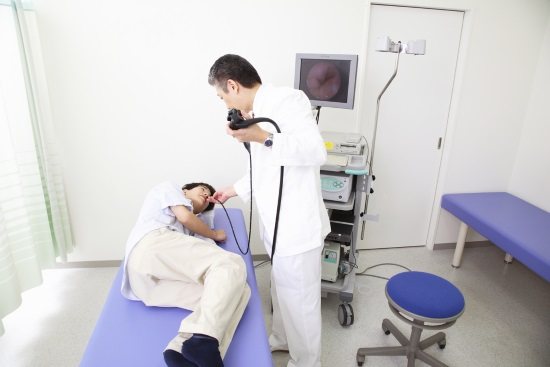
For example, with gastritis, much depends on whether it is acute or chronic, on treatment tactics and the presence of prerequisites for the development of concomitant pathologies. After diagnosis and treatment, a repeat examination is often necessary. This tactic allows you to objectively assess the effectiveness of therapy and make timely adjustments. Only a doctor will determine exactly how often FGS should be done, assess the feasibility of performing it during menstruation, and the possibility of prescribing it for concomitant diseases.
It is useful to conduct such a study solely for preventive purposes. There is no regulation on how many times a year the stomach needs to be examined. But as practice shows, an annual examination helps to promptly recognize the very first symptoms of diseases, when their treatment is most effective. Experts allow such a study to be performed as needed, but at least once every 5 years - even in the absence of any symptoms.
There is no need to worry about how often you can do an FGDS study of the stomach - the doctor who prescribes this study is able to assess all risk factors. The number of studies is not limited, it is considered so safe. During the procedure you can:
- detect the very first signs of mucosal damage that cannot be seen on ultrasound or fluoroscopy;
- determine the patency of the stomach and esophagus;
- identify the presence of strictures, narrowings, tumor formations or polyps;
- diagnose reflux and its degree.
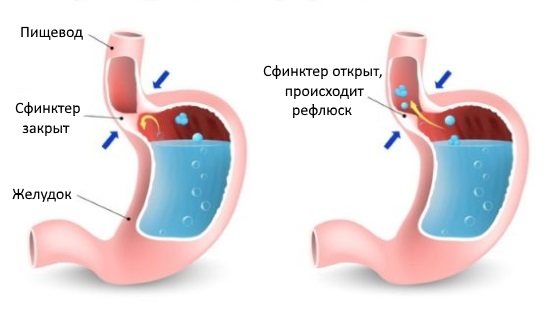
There is practically no need to prepare for FGS - the last meal is allowed at the patient’s usual time, the only thing you will have to give up is drinking alcohol and breakfast, since the study is carried out only on an empty stomach.
During such endoscopy, additional manipulations of a therapeutic or diagnostic nature are allowed. After FGS is done, the patient does not experience any discomfort. Occasionally, minor pain may occur when swallowing, which goes away on its own after a few hours and does not require medical intervention. The preparatory period is also extremely simple - it is enough not to eat anything directly on the day of the study.
Recently, video recording is often carried out on a computer, which significantly improves the quality of diagnostics. The doctor not only gets the opportunity to review the recording several times, but also consult with other specialists. This same point allows you to more accurately assess the effectiveness of the therapy.
In old age, the appointment of such an examination can be complicated by arterial hypertension and coronary heart disease - FGS certainly causes an increase in heart rate and a slight increase in blood pressure. In this case, transnasal FGDS may be prescribed, which opens up an additional opportunity for diagnosing the entire nasopharynx. At the same time, the patient retains the ability to communicate with the doctor, talking about his feelings, and when the probe is inserted, the gag reflex does not occur.
Source: diagnosticstinfo.ru
What is gastroscopy
Gastroscopy is a procedure that involves inserting an endoscope through the mouth. It allows you to view internal organs, such as the stomach, esophagus and others, and identify ulcerative and inflammatory processes, gastritis, and internal bleeding in the early stages.
If the doctor suspects an infectious disease or the presence of neoplasms, then during such a procedure he can take part of the tissue for subsequent study. FGS also detects polyps and allows you to quickly remove them, the same applies to internal bleeding.
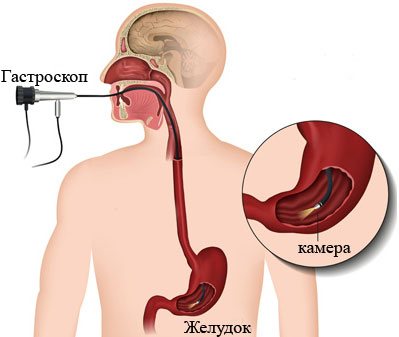
Frequency of the study
How often can a gastroscopy be done? Only the attending physician can answer this question, because the frequency of examinations depends on the characteristics of the disease.
loading…
It could be:
- A one-time test for suspected gastric disorders. If no gastric pathology is detected, then subsequent FGS is not necessary.
- Several times during the treatment course. In some cases, fibrogastroscopy is prescribed at short intervals during treatment. This is necessary to clarify the effectiveness of the therapy. Also, in case of illness, areas of the gastric wall can be irrigated with medication and other medical procedures.
- Once a year for uncomplicated stomach diseases for timely detection of possible deterioration in the early stages.
- In addition, 2-4 times a year if there is a predisposition to peptic ulcer disease or if surgical removal of a tumor of the stomach or duodenum was performed.
Fibrogastroscopy is a relatively safe and informative way to obtain information about the condition of the upper digestive tract. Of course, the procedure itself is quite unpleasant and many patients try to avoid it, but in vain: it is not recommended to neglect the prescribed examination, because it is better to promptly identify the pathology at an early stage than to treat advanced forms of the disease for a long time.
It is worth remembering that doctors prescribe this examination, which is unpleasant for the patient, only if there is a need for it; the number of times the doctor recommends the procedure, the same number of times FGS should be done.
Who needs gastroscopy
The procedure may be prescribed if the patient has prerequisites for a hernia, gastritis, ulcer, internal bleeding, as well as in case of regular complaints of pain in the stomach area. Gastroscopy is used to remove tissue from the stomach or other internal organ for a biopsy. For children, it can be prescribed for emergency removal of a foreign body from the stomach.
Gastroscopy is the most reliable procedure for determining diseases of the stomach, duodenum and other internal organs. Modern technologies have made it as safe and painless as possible.
Preparation for the procedure
Such a diagnosis is quite unpleasant and requires not only moral preparation, but also some abstinence from food. The last appointment should take place 10-12 hours before the procedure. This is due to the fact that undigested food in the stomach can give false data and make it difficult to access the stomach walls.
Sour, fried and spicy foods can inflame the mucous membranes, so before gastroscopy you need to exclude fatty fish and meats, cottage cheese, cheese, smoked and other foods from your diet for 1-2 days.
On the day before the test, you should not take medications, smoke or chew gum. It is also recommended that you avoid brushing your teeth, as toothpaste particles may
irritate mucous membranes. You can drink some warm water 2-3 hours before the procedure.
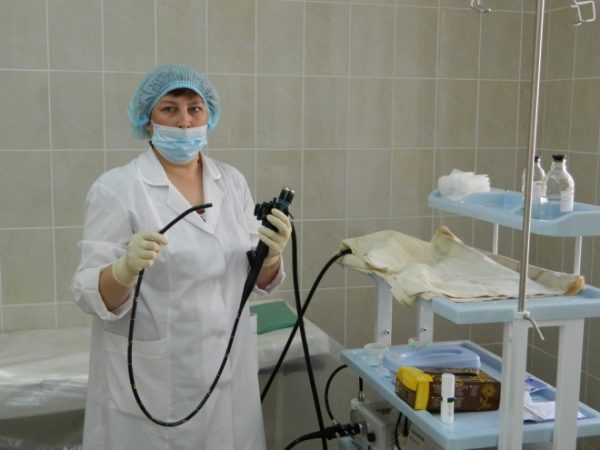
Fibrogastroscopy (FGS) – review
I admit that I didn’t just come up with the idea of reading the popular book about the Charming Intestines, but because I had problems with digestion.
Namely: a quick feeling of being full with food, overeating, heaviness in the stomach and nausea, as a result, I lost weight.
Having complained about these symptoms to my therapist, I received a referral for FGS (which I was not happy about, since this was, according to rumors, the unpleasant procedure I had to undergo for the first time).
Fibrogastroscopy (the exact name is fibroesophagogastroduodenoscopy), or FGS for short, is a method for examining the esophagus, stomach and duodenum using a special device (endoscope), which is a flexible tube with fiber optics.
☼ Where can fibrogastroscopy (FGS) be done?
I did FGS at the clinic at my place of residence, free of charge, since I had a referral from a doctor.
This study is also carried out in various paid clinics and centers.
☼ Fibrogastroscopy contraindications. Can this be done during menstruation?
A few days before the scheduled test, I began to worry even more because I discovered that my X days would most likely coincide with the date of the FGS. I had to google on the Internet: is it possible to do FGDS during menstruation? It turned out that there is negligible information on this issue, but this point is not mentioned in the contraindications:
- – acute myocardial infarction, acute stroke,
- – acute heart failure and chronic at a late stage,
- – sudden paroxysm of rhythm disturbances,
- – aortic aneurysm in the thoracic and abdominal region,
- – hemophilia (pathology of the blood coagulation system),
- – acute infectious diseases, diseases of the ENT organs – sore throat, tonsillitis, pharyngitis,
- – severe exhaustion or significant obesity of the patient,
- – mental illness in the acute phase, however, FGDS can be carried out for urgent indications during intravenous anesthesia after consultation with a psychiatrist.
For myself, I decided that if the date of FGS falls on the first or second day of menstruation, then I definitely will not go to the study (I thought that feeling unwell due to menstruation in its first days, fasting on the day of FGS and fear of the study do not go well together ).
However, everything worked out and nothing matched, so I had to go (
☼ How to prepare for fibrogastroscopy of the stomach? How much should you not eat before FGS? What should you not eat before FGS of the stomach?
I was unlucky, I was booked for 4:50 p.m., which meant I had to not eat or drink until at least 5:30 p.m. that day.
And yes, I did my best (due to the fact that I had to do the study not in the morning, but almost in the evening), and replaced the light dinner before the FGS of the stomach with one that was not at all light, but on the day of the study I even abstained from drinking water.
And I also realized that I have an addiction. The same as smokers, for example. When I woke up, my first thought was about HER. While talking on the phone, I couldn't concentrate because I was drawn to HIM.
Going to work seemed somehow absurd to my unclear consciousness; how can you go somewhere if you haven’t had IT all morning?! At work, my thoughts were poor, slow, my words were confused, my actions were uncertain, but at the same time my hands naturally reached for the cup, my legs moved toward the kettle on their own.
As you most likely guessed, SHE is food, HE is tea.
To my surprise, in the second half of the day I wanted to eat a little less than in the first, but the thought that I would be able to overcome my addiction scared me, so I myself warmed up dreams of the upcoming dinner after the study.
How did I feel before FGS? Apart from feeling hungry, I didn’t experience any particular discomfort. I had a slight headache, and it felt like my blood vessels didn’t like this whole hunger strike. There was also a slight weakness, however, in general, I endured the forced hunger strike more easily than I expected.
☼ How is gastric FGS done?
As luck would have it, there was no line in front of the office, and before I knew it, I found myself on the couch, face to face with the nurse. She asked if I had any allergies, then sprayed lidocaine into my mouth.
She put the towel I brought on the couch and told me to lie on my left side, with my left hand under me, and with my right hand I could hold on to the couch.
She left me in this position for several minutes, during which time the medicine took effect and everything in my mouth went numb.
The doctor came and told me to fasten the restrictor between the teeth, for some reason he said not to swallow the device, he would insert it correctly (I heard before that you had to swallow it), and warned that it might hurt a little.
When he inserted this hose with a light bulb at the end inside (to be honest, I expected it to be thinner, it seemed to me that it was at least a centimeter in diameter, or even more), I had the urge to vomit, however, when the device was already was in the stomach, and the doctor performed an examination, I was breathing like a locomotive (it probably turned out that during the insertion I couldn’t breathe at all), and there was no urge at all, I only felt this hose inside. When the device was removed, the urge was much less than when it was inserted. After that you could get up, it was all over.
Is it painful to do FGS of the stomach?
This study cannot be called painful (the pain is negligible), but only disgusting.
☼ How long does FGS of the stomach take?
I spent ten minutes in the office, this included administering lidocaine, waiting for it to take effect, positioning me on the couch, and having the doctor fill out all the paperwork at the end of the study.
☼ Fibrogastroscopy tests
During the FGS, they also took material from me for analysis for helicobacter pylori, as was written on the referral. It’s almost imperceptible, the doctor did it with some kind of “wire”, pushing it into the device that had already been inserted into my stomach (this is according to my feelings).
☼ Results of fibrogastroscopy
The doctor immediately gave me a description of my gastritis (apparently they don’t take photographs in our clinic), and he said that he would be tested for helicobacter pylori by the therapist in a week.
☼ When can you eat after FGS?
The doctor said that you can eat and drink right away, the effect of the painkiller will wear off in 10-15 minutes.
In addition to the fact that I have an addiction, on the day of the FGS I realized what life is like for people with speech impediments.
The nurse asked me to give my last name in order to find out who skipped the FGS (I already said that for some reason there was no queue, and no one showed up after me either, a clinic without a queue is no longer a clinic), all I got in response was bleating , grunting and mooing, she had to ask again, the intrigue dissolved when the doctor read my name from my card, and it was all the fault of the painkiller)
☼ My feelings after FGS
The sensations of the intervention persisted the next day: my throat was scratched, the mucous membrane in my mouth was damaged, I felt as if there was a taste of medicine (maybe it was the taste of medicine, I don’t know), traces of the intervention were also felt in my stomach.
Everything went away within a day.
☼ Conclusions
If you have health problems and your doctor has prescribed FGS, you should definitely do it. At least for the sake of your own peace of mind, and, of course, to identify the causes of existing problems in the digestive system and proper treatment. The procedure can be endured; it takes very little time.
And what prompted me to guess about the causes of my problems was written in the book by J. Enders The Charming Intestines)
My story of long-awaited relief from debilitating symptoms, oh, this dysbiosis! (Myths about clear skin and bifiform, just myths?
All my reviews are here
Source: https://irecommend.ru/content/fibrogastroskopiya-issledovanie-nepriyatnoe-no-bystroe-luchshe-sdelat-chem-gadat-otvety-skol
Procedure frequency
Gastroscopy is performed using an endoscope - a modern and precise device that can penetrate the esophagus. The procedure cannot be called pleasant; it is for this reason that many patients, not taking into account its significance in diagnosis, try in every possible way to avoid it.
Among patients with chronic gastritis or other gastrointestinal diseases, there is an opinion that such a procedure cannot be performed often. However, doctors claim that this assumption is nothing more than a myth and it arose as a result of reluctance to undergo this procedure.
Is it possible to perform the procedure for gastritis?
Modern conditions in clinics and high-quality equipment allow this procedure to be performed as accurately and quickly as possible. It can be done an unlimited number of times, due to the fact that the endoscope does not harm the human body and, in particular, its internal organs.
Whether gastroscopy can be performed for gastritis and how many times it will be required is decided only by the attending physician. In some cases, during an exacerbation of the disease, this procedure may be postponed for some time, but if there is an urgent need, it can be performed.
An equally common question is performing a gastroscopy if menstruation has begun. In general, they will not affect the result of the internal study in any way, but in any case the doctor should be aware.

Is it possible to do a gastroscopy during menstruation?
There is no connection between menstruation and gastroscopy. You can get tested on any day of your cycle.
The only thing that women's days can affect is your emotional state.
If you are subject to strong mood swings - increased anxiety, tearfulness, sensitivity, or, on the contrary, everything begins to irritate you, then wait a few days and come back when your hormonal and emotional background has leveled out.
Your positive attitude will make the procedure more comfortable.
If you have a cold (acute respiratory infection, acute respiratory viral infection), it is advisable to reschedule the procedure to another day after complete recovery. And there are many reasons for this:
1 — With colds, nasal breathing is difficult. Mouth breathing will be somewhat limited and if you also have a stuffy nose, it will be difficult to breathe.
2 - If your throat hurts and you have a cough, then gastroscopy will only strengthen the cough reflex. In addition, inserting a gastroscope will be problematic if you have a particularly dry and paroxysmal cough.
3 - Using a gastroscope, the infection can go lower.
4 – Inflamed throat tissues are more susceptible to damage.
5 – When you have a cold, the upper respiratory tract is usually swollen. And the introduction of a gastroscope can cause spasm of the respiratory tract and the development of acute respiratory failure.
6 – Well, I don’t care about spreading the infection)) Doctors are people too, just like other patients of the clinic.
Get well first, and then welcome to us. We will perform gastroscopy in the best possible way - professionally, quickly, painlessly and comfortably.
Make an appointment at a time convenient for you by filling out the application form or calling us at 8 (495) 201-96-92.
We work without crowds in the clinic and queues!
By filling out the form, you consent to the processing of personal data in accordance with Federal Law-152 of the Russian Federation
Fibrogastroduodenoscopy (common abbreviation - FGDS) or upper endoscopy is a method that allows you to visualize in detail the condition of the mucous membrane of the upper gastrointestinal tract, specifically: the stomach, esophagus and duodenum (the initial part of the small intestine). The procedure is one of the most popular types of diagnostics by gastroenterologists. It is prescribed for a number of diseases and is used to achieve preventive and therapeutic purposes.
Why do you need to do FGDS?
- bleeding;
- weight loss;
- swallowing disorder;
- anemia;
- regularly recurring vomiting;
- frequent chest pain;
- suffocation.
This study is used to diagnose diseases of the stomach, esophagus, and intestines. At the same time, modern technology makes it possible to conduct video recording, take biopsy material, and stain suspicious areas to exclude or confirm oncological pathology.
An additional function of the study is the ability to determine the acidity of gastric juice.
FGDS can be not only a diagnostic, but also a therapeutic procedure in cases where endoscopic hemostasis (stopping bleeding), removal of polyps or sclerosis of dilated veins of the esophagus or stomach is performed.
We recommend that you read the material: Help with gastrointestinal bleeding.
Preparation for FGDS
There is no need for special training. It is enough to eliminate food and water intake for 10 hours, and also not smoke. If acidity is to be determined, then for 5-6 days it is necessary to stop taking medications that affect it (both reducing and stimulating).
We are talking about the following drugs:
- Antisecretory (lowering Ph): proton pump inhibitors (omeprazole, lanzoprazole, rabeprazole, esomeprazole, pantoprazole), anticholinergics, H2 blockers, bismuth preparations.
- Stimulating and replacing Ph (preparations based on plantain, bitterness, as well as: gastric juice, hydrochloric acid, acedin-pepsin).
How is FGDS performed?
During the procedure, the patient is placed on his side; before this, the pharynx is treated with an anesthetic solution to reduce discomfort during the examination. A mouthpiece is inserted into the mouth to prevent biting of the device.
The patient needs to listen carefully to the doctor’s instructions and calmly follow them: breathe deeply and calmly through the nose, do not swing your limbs, do not try to grab something that should not be grabbed.
The manipulation is performed by an endoscopist.
If you believe the reviews about FGDS, then it is better not to treat the pharynx, since the pain is not pronounced, but there is a feeling of the inability to swallow and inhale after anesthesia. Large clinics often offer the use of intravenous anesthesia.
Existing contraindications to gastroscopy
FGDS is strongly not recommended in the acute period of myocardial and cerebral infarction, as well as in patients suffering from severe attacks of bronchial asthma, mental illness, and bleeding disorders.
However, for urgent indications, manipulation in a hospital setting is allowed.
Patients often ask whether it is possible to do FGDS during menstruation? We answer that this condition is not one of the absolute or indirect contraindications. So it's possible.
Possible risks
Complications during this procedure are extremely rare. And they are associated primarily with the fault of the patient himself, who does not follow the specialist’s recommendations, and also as a result of the anatomical features of the internal organs.
- Allergic reactions in the presence of intolerance to certain components;
- Puncture with an endoscope;
- Ingestion of infection;
- The development of short-term bleeding as a result of microtrauma of the intestine or other organ.
In some cases, upon completion of such a diagnosis, the patient may feel a feeling of nausea, sore throat and difficulty swallowing. However, these symptoms go away on their own after 1-2 days and are not a cause for concern.
Gastroscopy is a safe and effective procedure that allows you to make a diagnosis with high accuracy. It is carried out with the frequency that is necessary, in the opinion of the attending physician.
